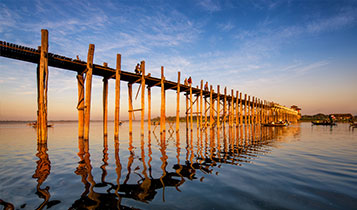
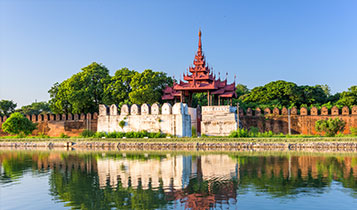
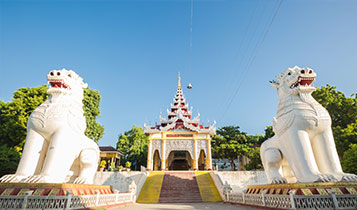
Mandalay is the second-largest city and the last royal capital of Myanmar (Burma). Located 716 km (445 mi) north of Yangon on the east bank of the Irrawaddy River, the city has a population of 1,225,553 (2014 census). Mandalay is the economic centre of Upper Burma and considered the centre of Burmese culture.
Like most former (and present) capitals of Burma, Mandalay was founded on the wishes of the ruler of the day. On 13 February 1857, King Mindon founded a new royal capital at the foot of Mandalay Hill, ostensibly to fulfill a prophecy on the founding of a metropolis of Buddhism in that exact place on the occasion of the 2,400th jubilee of Buddhism.
The new capital city site was 66 km2 (25.5 sq mi) in area, surrounded by four rivers. The plan called for a 144-square block grid patterned citadel, anchored by a 16 square block royal palace compound at the center by Mandalay Hill. The 1020-acre (413-hectare) citadel was surrounded by four 2,032 m (6,666 ft) long walls and a moat 64 m (210 ft) wide, 4.6 m (15 ft) deep. At intervals of 169 m (555 ft) along the wall, were turrets with gold-tipped spires for watchmen. The walls had three gates on each side, and five bridges to cross the moat. In addition, the king also commissioned the Kuthodaw Pagoda, the Pahtan-haw Shwe Theinupasampada hall, the Thudamma "Good Dharma" zayats or public houses for preaching Buddhism and a library for the Pāli Canon.
In June 1857, the former royal palace of Amarapura was dismantled and moved by elephants to the new location at the foot of Mandalay Hill, although construction of the palace compound was officially completed only two years later, on Monday, 23 May 1859.
For the next 26 years, Mandalay was to be the last royal capital of the Konbaung Dynasty, the last independent Burmese kingdom before its final annexation by the British Empire. Mandalay ceased to be the capital on 28 November 1885 when the conquering British sent Thibaw Min and his queen Supayalat into exile, ending the Third Anglo-Burmese War.
Mandalay is located in the central dry zone of Burma by the Irrawaddy river at 21.98° North, 96.08° East, 80 meters (260 feet) above sea level. Its standard time zone is UTC/GMT +6:30 hours. Mandalay lies along the Sagaing Fault.Bodies of water near Mandalay are Mandalay Kantawgyi, a small lake and Irawaddy River to the west of the city.
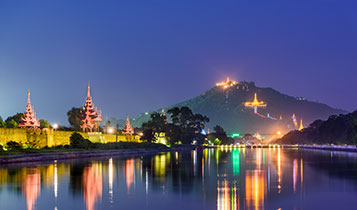
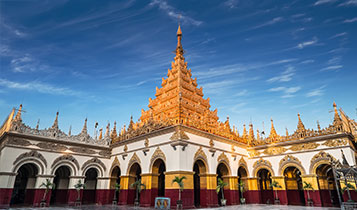
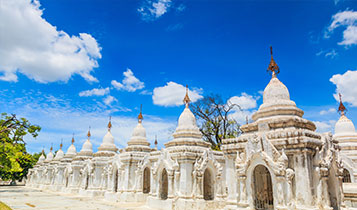
The "Atumashi kyaung", which literally means "inimitable vihara", is also one of the well known sights. The original structure was destroyed by a fire in 1890 though the masonry plinth survived. It was indeed an inimitable one in its heyday. The reconstruction project was started by the government on 2 May 1995 and completed in June 1996.
One of the Buddha's Sacred Replica Tooth Relics was enshrined in the Mandalay Swedaw Pagoda on Maha Dhammayanthi Hill in Amarapura Township. The pagoda was built with cash donations contributed by the people of Burma and Buddhist donors from around the world under the supervision of the State Peace and Development Council. The authorities and donors hoisted Buddha's Replica Tooth Relic Pagoda Mandalay's Shwe Htidaw (sacred golden umbrella), Hngetmyatnadaw (sacred bird perch vane) and Seinhpudaw (sacred diamond bud) on 13 December 1996.
Built by King Mindon in 1857, this pagoda modeled on the Shwezigon Pagoda at Nyaung-U, is surrounded by 729 upright stone slabs on which are inscribed the entire Tipitaka as edited and approved by the Fifth Buddhist council. It is popularly known as "World's largest book" for its stone scriptures.
Near the southern approach to Mandalay Hill stands the Kyauktawgyi Buddha image built by King Mindon in 1853–78. The Image was carved out of a huge single block of marble. Statues of 80 arahants are assembled around the Image, twenty on each side. The carving was completed in 1865.
The image of Gautama Buddha at Mahamuni Buddha Temple is said to have been cast in the life-time of the Gautama Buddha and that the Buddha embraced it seven times, thereby bringing it to life. Consequently, devout Buddhists hold it to be alive and refer to it as the Mahamuni Sacred Living Image. Revered as the holiest pagoda in Mandalay, It was built by King Bodawpaya in 1784. The image in a sitting posture is 12 feet and 7 inches (3.8 m) high. As the image was brought from Rakhine State, it was also called the Great Rakhine Buddha. The early morning ritual of washing the Face of Buddha Image draws a large crowd of devotees everyday. The Great Image is also considered as the greatest in Burma next to Shwedagon Pagoda. A visit to Mandalay is incomplete without a visit to Mahamuni Pagoda.
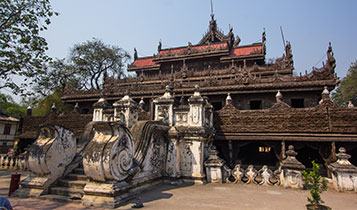
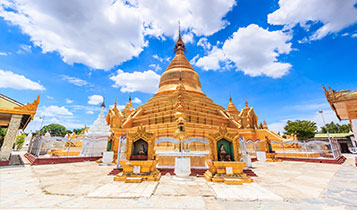
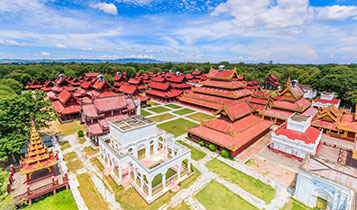
The hill has for long been a holy mount. Legend has it that the Buddha, on his visit, had prophesied that a great city would be founded at its foot. Mandalay Hill, 230 metres in elevation, commands a magnificent view of the city and surrounding countryside. The construction of a motor road to reach the hill-top has already been finished.
The whole magnificent palace complex was destroyed by a fire during World War II. However, the finely built palace walls, the city gates with their crowning wooden pavilions and the surrounding moat still represent an impressive scene of the Mandalay Palace, "Mya-nan-san-kyaw Shwenandaw", which has been rebuilt using forced labor. A model of the Mandalay Palace, Nanmyint-saung and Mandalay Cultural Museum are located inside the Palace grounds.
Famous for its intricate wood carvings, this monastery is a fragile reminder of the old Mandalay Palace. Actually, it was a part of the old palace later moved to its current site by King Thibaw in 1880.
The Chinese Temple, well known for its old artistic architectures and cultural artifacts, reflects Mandalay's old history.
A small zoo between the Mandalay Palace and Mandalay Hill. It has over 300 species and is h4notably the only zoo to have Burmese roofed turtles.
Mandalay's strategic location in Central Burma makes it an important hub for transport of people and goods. The city is connected to other parts of the country and to China and India by multiple modes of transportation.
Buddha relics from Kanishka stupain Peshawar, Pakistan, now in Mandalay. Teresa Merrigan, 2005 Mandalay is Burma's cultural and religious center of Buddhism, having numerous monasteries and more than 700 pagodas. At the foot of Mandalay Hill sits the world's official "Buddhist Bible", also known as the world's largest book, in Kuthodaw Pagoda. The styles of Mandalay Buddha Images and Buddha Statues were many since King Mandon, who was a devout Buddhist, and had filled Mandalay with them and through the years Mandalay Buddhist art became established as the pure art of Myanmar. There are 729 slabs of stone that together are inscribed with the entire Pāli canon, each housed in its own white stupa. The buildings inside the old Mandalay city walls, surrounded by a moat, which was repaired in recent times using prison labor, comprise the Mandalay Palace, mostly destroyed during World War II. İt is now replaced by a replica, Mandalay Prison and a military garrison, the headquarters of the Central Military Command
Mandalay is the major trading and communications center for northern and central Burma. Much of Burmese external trade to China and India goes through Mandalay. Among the leading traditional industries are silk weaving, tapestry, jade cutting and polishing, stone and wood carving, making marble and bronze Buddha images, temple ornaments and paraphernalia, the working of gold leaves and of silver, the manufacture of matches, brewing and distilling.